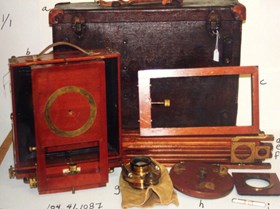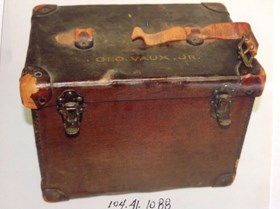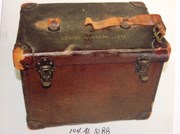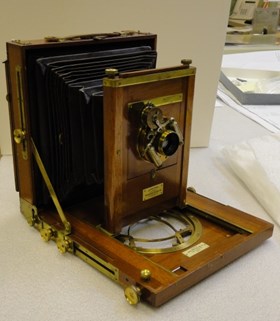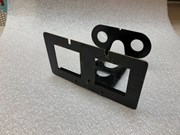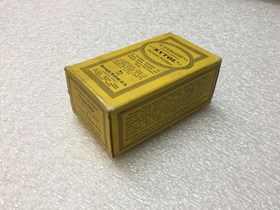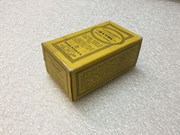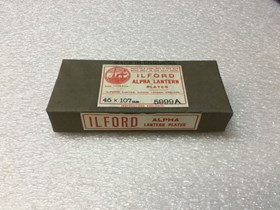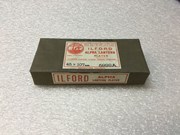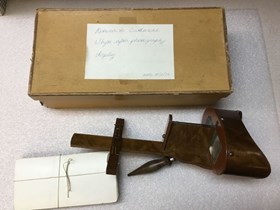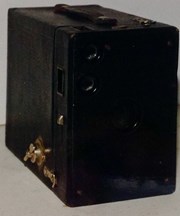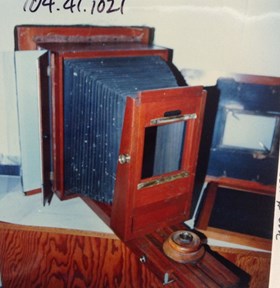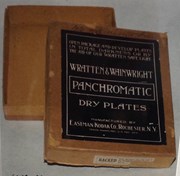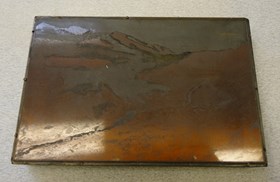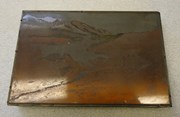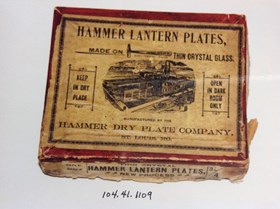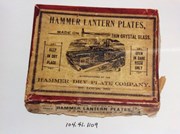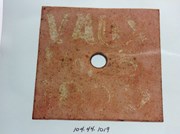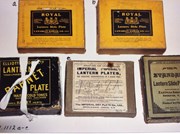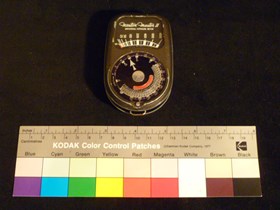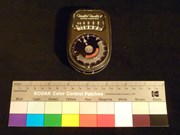Narrow Results By
- Date
- 1890 – 1905
- Material
- fibre; paper; skin; metal; glass; wood
- Catalogue Number
- 104.41.1087 a-k
- Description
- Large format 6 1/2” x 8 1/2” folding wooden field view camera (b) with brass fittings marked “IMPROVED EMPIRE STATE. MANUFACTURED BY ROCHESTER OPTICAL CO. ROCHESTER, N.Y.” With collapsable wood and brass tripod legs (d,e,f) marked “FOLMER & SCHWING MFG. CO. NEW YORK. CROWN No. 2. PAT. JUNE 23, 1903…
1 image
- Title
- View Camera
- Date
- 1890 – 1905
- Material
- fibre; paper; skin; metal; glass; wood
- Dimensions
- 40.0 x 47.0 cm
- Description
- Large format 6 1/2” x 8 1/2” folding wooden field view camera (b) with brass fittings marked “IMPROVED EMPIRE STATE. MANUFACTURED BY ROCHESTER OPTICAL CO. ROCHESTER, N.Y.” With collapsable wood and brass tripod legs (d,e,f) marked “FOLMER & SCHWING MFG. CO. NEW YORK. CROWN No. 2. PAT. JUNE 23, 1903”, wood and brass tripod top (h), small level marked “C.E. JENNINGS & CO. NEW YORK” (j), spare camera rack (c), and black light safe hood (k). Brass and glass lens in a soft leather bag (g) marked: “6 1/2 x 8 1/2 PLASTIGMAT. Pat. Oct. 30, 1900. Bausch & Lomb Optical Co. Rochester, N.Y. 359514” & “20859”. Aperture dial stamped: “BAUSCH & LOMB OPT. CO. PAT. JAN. 8, 1891. NEW YORK. ROCHESTER, N.Y. CHICAGO.” Lens in soft chamois pouch. All items fit inside brown fabric covered hard case (a) with leather reinforced corners, marked: “GEO. VAUX, JR.”
- Subject
- photography
- Vaux family
- Credit
- Gift of Molly Vaux, New York, USA, 1999
- Catalogue Number
- 104.41.1087 a-k
Images
This material is presented as originally created; it may contain outdated cultural descriptions and
potentially offensive content.
Read more.
- Date
- 1890 – 1900
- Material
- wood; metal; plastic; fibre; skin; paper
- Catalogue Number
- 104.41.1088 a-k
- Description
- Ten wooden plateholders (a-j) individually numbered, some stamped: “ROCHESTER OPTICAL CO. PAT. JULY 29, 1890”. All plateholders fit inside brown fabric covered hard case (k) with leather reinforced corners, marked: “GEO. VAUX, JR.”
1 image
- Title
- Plateholder
- Date
- 1890 – 1900
- Material
- wood; metal; plastic; fibre; skin; paper
- Dimensions
- 23.0 x 30.0 cm
- Description
- Ten wooden plateholders (a-j) individually numbered, some stamped: “ROCHESTER OPTICAL CO. PAT. JULY 29, 1890”. All plateholders fit inside brown fabric covered hard case (k) with leather reinforced corners, marked: “GEO. VAUX, JR.”
- Subject
- photography
- Vaux family
- Credit
- Gift of Molly Vaux, New York, USA, 1999
- Catalogue Number
- 104.41.1088 a-k
Images
This material is presented as originally created; it may contain outdated cultural descriptions and
potentially offensive content.
Read more.
- Date
- 1890 – 1905
- Material
- wood; metal; fibre; glass; skin
- Catalogue Number
- 104.41.1089 a-i
- Description
- Large format 6 1/2” x 8 1/2” folding wooden field view camera (a) with brass fittings, marked: “CARLTON. Manufactured by ROCHESTER OPTICAL CO. Rochester, N.Y. PAT. AUG. 31, 1886”. Another plate reads: “Bought of CHEYNEY-HOOD PHOTO. SUPPLY CO. 1006 FILBERT ST., PHILA.” With collapsable wood and bras…
1 image
- Title
- View Camera
- Date
- 1890 – 1905
- Material
- wood; metal; fibre; glass; skin
- Dimensions
- 35.0 x 64.0 cm
- Description
- Large format 6 1/2” x 8 1/2” folding wooden field view camera (a) with brass fittings, marked: “CARLTON. Manufactured by ROCHESTER OPTICAL CO. Rochester, N.Y. PAT. AUG. 31, 1886”. Another plate reads: “Bought of CHEYNEY-HOOD PHOTO. SUPPLY CO. 1006 FILBERT ST., PHILA.” With collapsable wood and brass tripod legs (f,g,h), one lens filter in leather box (e), a red photographic notebook (d), one optical finder/plate-reading magnifying glass (c), and a brass and glass lens (b) marked: “BAUSCH & LOMB OPT. CO. PAT. JAN. 6, 1891. ROCHESTER, N.Y., NEW YORK CITY. 9703.” Lens in soft chamois pouch. All items fit inside khaki canvas covered hard case (i) with leather strap mounts. Two canvas straps hold case closed.
- Subject
- photography
- Vaux family
- Credit
- Gift of Molly Vaux, New York, USA, 1999
- Catalogue Number
- 104.41.1089 a-i
Images
This material is presented as originally created; it may contain outdated cultural descriptions and
potentially offensive content.
Read more.
- Date
- 1883 – 1926
- Material
- cardboard; metal; glass;
- Catalogue Number
- 104.41.0129 a,b
- Description
- Two camera lenses housed in a repurposed Hammond box with “OLD ‘ADON’ Telephoto in shutter circa 1990’s” written in black ink on the front.The larger lens with shutter was manufactured by Bausch & Lomb Optical Co., originally a company that produced prescription eye-wear in the mid to late-1800s be…
1 image
- Title
- Camera Lenses
- Date
- 1883 – 1926
- Material
- cardboard; metal; glass;
- Dimensions
- 5.7 x 7.8 x 14.5 cm
- Description
- Two camera lenses housed in a repurposed Hammond box with “OLD ‘ADON’ Telephoto in shutter circa 1990’s” written in black ink on the front.The larger lens with shutter was manufactured by Bausch & Lomb Optical Co., originally a company that produced prescription eye-wear in the mid to late-1800s before expanding into camera lenses and microscopes/telescopes towards the turn of the century. The company was founded in Rochester NY.The smaller lens was manufactured by Gundlach-Manhattan Optical Co., a merged company between Gundlach Optical Co. and Manhattan Optical Co. that took place in 1902, which produced various kinds of bellows cameras. Both companies were based in Rochester NY prior to merging.
- Credit
- Gift of Nicholas Morant, Banff, 2006
- Catalogue Number
- 104.41.0129 a,b
Images
This material is presented as originally created; it may contain outdated cultural descriptions and
potentially offensive content.
Read more.
- Date
- 1893 – 1930
- Material
- metal; glass;
- Catalogue Number
- 105.05.0035
- Description
- Black metal folding stereoscope. The rectangular frame has two square openings that allow light to pass through the image, which is inserted into tracks on the inside of the frame. Opposite the rectangular frame is a rounded frame containing two round glass lenses that also has a rounded cut-out wh…
1 image
- Title
- Stereoscope
- Date
- 1893 – 1930
- Material
- metal; glass;
- Dimensions
- 7.1 x 13.5 x 7.5 cm
- Description
- Black metal folding stereoscope. The rectangular frame has two square openings that allow light to pass through the image, which is inserted into tracks on the inside of the frame. Opposite the rectangular frame is a rounded frame containing two round glass lenses that also has a rounded cut-out where the nose can fit. Between the two frames is an adjustable plate, allowing the image to be moved further from or closer to the viewer in order to be brought into focus. The stereoscope folds in on itself and latches with a small gold flat-top peg that fits into a small slot on the lens frame.
- Subject
- Crosby family
- Abegweit
- photography
- stereoscopes
- Credit
- Gift of Robert Crosby Family, Banff, 1998
- Catalogue Number
- 105.05.0035
Images
This material is presented as originally created; it may contain outdated cultural descriptions and
potentially offensive content.
Read more.
Photograph Developer
https://archives.whyte.org/en/permalink/artifact104.41.0203
- Date
- 1880 – 1940
- Material
- cardboard;
- Catalogue Number
- 104.41.0203
- Description
- Empty cardboard box of Burroughs Wellcome & Co. ‘Tabloid’ (Photographic) ‘Rytol’ Universal Developer that could be used on plates, film, bromide and gaslight papers, and glass lantern slides. Directions on how to use the developer are printed in black throughout the yellow box. Developers were eith…
1 image
- Title
- Photograph Developer
- Date
- 1880 – 1940
- Material
- cardboard;
- Dimensions
- 9.0 x 4.0 x 5.1 cm
- Description
- Empty cardboard box of Burroughs Wellcome & Co. ‘Tabloid’ (Photographic) ‘Rytol’ Universal Developer that could be used on plates, film, bromide and gaslight papers, and glass lantern slides. Directions on how to use the developer are printed in black throughout the yellow box. Developers were either chemical powders or liquids that would be added to another agent [usually a bath] to create a solution that would then be used to expose the positive photograph after it had been transferred from the original negative. Different concentrations or chemicals used could yield different results, usually in regards to contrast and colour of the finished image, depending on the photographic base.
- Credit
- Gift of Robert Crosby Family, Banff, 1998
- Catalogue Number
- 104.41.0203
Images
This material is presented as originally created; it may contain outdated cultural descriptions and
potentially offensive content.
Read more.
Lantern Plates
https://archives.whyte.org/en/permalink/artifact104.41.0206
- Date
- 1889 – 1910
- Material
- paper; glass;
- Catalogue Number
- 104.41.0206
- Description
- One paper-wrapped package of 45x107mm Ilford Alpha Lantern Plates with white and red paper adhesive labels on the top and front of the package containing manufacturer details. These lantern plates would serve as the positive mount for the lantern slide made from the original negative. Lantern slide…
1 image
- Title
- Lantern Plates
- Date
- 1889 – 1910
- Material
- paper; glass;
- Dimensions
- 2.0 x 11.6 x 5.3 cm
- Description
- One paper-wrapped package of 45x107mm Ilford Alpha Lantern Plates with white and red paper adhesive labels on the top and front of the package containing manufacturer details. These lantern plates would serve as the positive mount for the lantern slide made from the original negative. Lantern slides are glass-based transparencies that were displayed by being projected through an early projector called a magic lantern. Starting as hand-painted images on glass, lantern slides quickly adapted to first black-and-white and then colour photography and faded from popularity with the rise of celluloid film and motion pictures.
- Credit
- Gift of Robert Crosby Family, Banff, 1998
- Catalogue Number
- 104.41.0206
Images
This material is presented as originally created; it may contain outdated cultural descriptions and
potentially offensive content.
Read more.
- Date
- 1883 – 1979
- Material
- cardboard; wood; metal;
- Catalogue Number
- 105.05.0040 a,b
- Description
- Wooden hand-held stereoscope with a long base along which the card frame can slide, goggle-shaped lens housing that blocks out light around the sides, two square lenses angled slightly towards the center, a central blocker, and a pointed fold-down handle. The card frame is a separate piece that sli…
1 image
- Title
- Stereoscope
- Date
- 1883 – 1979
- Material
- cardboard; wood; metal;
- Dimensions
- 10.1 x 33.5 x 16.0 cm
- Description
- Wooden hand-held stereoscope with a long base along which the card frame can slide, goggle-shaped lens housing that blocks out light around the sides, two square lenses angled slightly towards the center, a central blocker, and a pointed fold-down handle. The card frame is a separate piece that slides on and off the end of the long base and features two wire holders that fold out to fit the card. Also includes a stack of manufactured stereoscope cards that mostly feature scenes from Palestine and the United States that have spots of colour tinting, possibly hand-applied. Everything is housed in a cardboard shoe box with a white “COES & STODDER” sticker on one short side. Written on one short side of the lid is “STEREOPTICAN” in black ink and taped to the lid is a piece of paper that reads “Return to Catharine Whyte after photograph display” signed and dated by Maryalice Stewart 14 February 1979.
- Subject
- souvenir
- commemorative
- photography
- Credit
- Gift of Catharine Robb Whyte, O. C., Banff, 1979
- Catalogue Number
- 105.05.0040 a,b
Images
This material is presented as originally created; it may contain outdated cultural descriptions and
potentially offensive content.
Read more.
- Date
- 1890 – 1900
- Material
- cardboard;
- Catalogue Number
- 110.01.0293 a-c
- Description
- Three empty boxes for one Transparent Film Cartridge meant to be used in the Kodak No. 2 Bullet Camera - each cartridge could take twelve 3 1/2 inch exposures. Each box has a black and white paper label adhered across the top of the lid with the product and manufacturer details printed throughout -…
1 image
- Title
- Film Box
- Date
- 1890 – 1900
- Material
- cardboard;
- Dimensions
- 3.8 x 4.0 x 10.3 cm
- Description
- Three empty boxes for one Transparent Film Cartridge meant to be used in the Kodak No. 2 Bullet Camera - each cartridge could take twelve 3 1/2 inch exposures. Each box has a black and white paper label adhered across the top of the lid with the product and manufacturer details printed throughout - on the bottom is a white and red paper label with a warning to develop the film before May 1st, 1900. All three boxes have various kinds of writing throughout the exteriors - two have notes written on one long side in pencil by Russell Robb [most likely Catharine’s father].
- Subject
- photography
- photographic developing
- film
- Credit
- Gift of Catharine Robb Whyte, O. C., Banff, 1979
- Catalogue Number
- 110.01.0293 a-c
Images
This material is presented as originally created; it may contain outdated cultural descriptions and
potentially offensive content.
Read more.
- Date
- c. 1900
- Material
- wood; metal; glass
- Catalogue Number
- 104.41.0243
- Description
- A folding wooden camera with gold metal features. When folded the main body of the camera lens is set into the centre of the wooden frame surrounded by a circular opening with a metal circle that is able to twist [where the tripod would attach]. The camera opens from a hinge to fold out, releasing …
1 image
- Title
- Wooden Camera
- Date
- c. 1900
- Material
- wood; metal; glass
- Description
- A folding wooden camera with gold metal features. When folded the main body of the camera lens is set into the centre of the wooden frame surrounded by a circular opening with a metal circle that is able to twist [where the tripod would attach]. The camera opens from a hinge to fold out, releasing the black bellows, the front with the camera lens is on hinges that allow the camera lens to be propped up from the front frame that protected it. There are hinges to secure the position of the lens, there is also knobs and gears to operate the camera and a fibre cord with a metal ring attached to the bottom of the lens. On the base of the frame (which protects the lens when folded), features knobs that can twist to extend the length of the bellows, this part of the frame is inlaid in the base. On the back of the camera is another frame with a glass insert that is held in place with a clasp and on hinges. Along the side of this part of the camera are knobs on hinges to support when the bellows are extended further and inlaid is a white circle label which reads “THE Sandringham REG.” in brown text.
- Credit
- Gift of L. A. E Duncan, Calgary, 1980
- Catalogue Number
- 104.41.0243
Images
This material is presented as originally created; it may contain outdated cultural descriptions and
potentially offensive content.
Read more.
Developing Tray
https://archives.whyte.org/en/permalink/artifact104.41.0272
- Date
- c. 1900
- Material
- ceramic; enamel
- Catalogue Number
- 104.41.0272
- Description
- A white tray with different coloured speckles all over with a pouring spout at one corner. On the side with the pouring spout is a stamp that reads “GRANITINE” in an outer ring of a circle with a symbol or logo in the middle.
1 image
- Title
- Developing Tray
- Date
- c. 1900
- Material
- ceramic; enamel
- Dimensions
- 4.9 x 15.0 x 21.5 cm
- Description
- A white tray with different coloured speckles all over with a pouring spout at one corner. On the side with the pouring spout is a stamp that reads “GRANITINE” in an outer ring of a circle with a symbol or logo in the middle.
- Credit
- Gift of Pearl Evelyn Moore, Banff, 1977
- Catalogue Number
- 104.41.0272
Images
This material is presented as originally created; it may contain outdated cultural descriptions and
potentially offensive content.
Read more.
- Date
- 1897 – 1930
- Material
- metal, wood, glass
- Catalogue Number
- 104.41.1044
- Description
- Brownie box camera No 2A; leather textured cloth covered cardboard body; internal lens with 2viewfinder lens above; viewfinder windows top and side; shutter release underside viewfinder window, film winding knob this side also; front and back detachable; broken amber window on back; aperture lever …
1 image
- Title
- Box Camera
- Date
- 1897 – 1930
- Material
- metal, wood, glass
- Dimensions
- 15.5 x 12.9 x 8.7 cm
- Description
- Brownie box camera No 2A; leather textured cloth covered cardboard body; internal lens with 2viewfinder lens above; viewfinder windows top and side; shutter release underside viewfinder window, film winding knob this side also; front and back detachable; broken amber window on back; aperture lever on front portion; leather carrying handle with model name and number embossed.
- Subject
- photography
- Credit
- Gift of Richard Colley, Calgary, 1986
- Catalogue Number
- 104.41.1044
Images
This material is presented as originally created; it may contain outdated cultural descriptions and
potentially offensive content.
Read more.
Enlarging Camera
https://archives.whyte.org/en/permalink/artifact104.41.1021%20a-c
- Date
- 1897 – 1915
- Material
- wood; brass; cloth; glass
- Catalogue Number
- 104.41.1021 a-c
- Description
- Enlarging view camera with two backs; mahogany wood construction; rubberized cloth bellows; some brass fittings;front piece rides on track; brass knob on side moves lens mounting plate; 2 pieces for tracks tightening wood knob; slots for glass plates behind hinged door; one plate clear glass, one p…
1 image
- Title
- Enlarging Camera
- Date
- 1897 – 1915
- Material
- wood; brass; cloth; glass
- Dimensions
- 61.0 x 56.4 x 46.0 cm
- Description
- Enlarging view camera with two backs; mahogany wood construction; rubberized cloth bellows; some brass fittings;front piece rides on track; brass knob on side moves lens mounting plate; 2 pieces for tracks tightening wood knob; slots for glass plates behind hinged door; one plate clear glass, one plate frosted glass; large slot for backs to slide in; two backs: one 42.3 x 33.1; other 59.9 x 41.9; the smaller back has two black slides, sheet frosted glass, cardboard divider; larger back has an area in centre with piece of glass with clips; carpet nailed around edges of slot and also perimeter of back piece; manufacturer's name plate loose.
- Subject
- photography
- Byron Harmon
- Credit
- Gift of Don Harmon, Banff, 1966
- Catalogue Number
- 104.41.1021 a-c
Images
This material is presented as originally created; it may contain outdated cultural descriptions and
potentially offensive content.
Read more.
- Date
- 1885 – 1890
- Material
- wood; metal; skin
- Catalogue Number
- 104.41.1010 a,b
- Description
- “Premo D” folding camera (4”x5” format) with a leather covered wooden frame. The camera has a leather handle centred on the top and held in place with brass keepers. The hinged front of the camera opens to lie flat and has a brass track (3.2 cm wide) running down the centre. The red leather bell…
1 image
- Title
- Camera
- Date
- 1885 – 1890
- Material
- wood; metal; skin
- Dimensions
- 12.0 x 14.5 x 17.5 cm
- Description
- “Premo D” folding camera (4”x5” format) with a leather covered wooden frame. The camera has a leather handle centred on the top and held in place with brass keepers. The hinged front of the camera opens to lie flat and has a brass track (3.2 cm wide) running down the centre. The red leather bellows extend along the track and end with a wooden frame that holds a lens (missing) and a viewfinder. The camera also has hinged doors on the right side and on the back.b) Film plate holder loaded in the camera’s side chamber.
- Subject
- households
- photography
- hobbies
- Credit
- Gift of Unknown, 1968
- Catalogue Number
- 104.41.1010 a,b
Images
This material is presented as originally created; it may contain outdated cultural descriptions and
potentially offensive content.
Read more.
Photograph Accessory
https://archives.whyte.org/en/permalink/artifact104.41.1013
- Date
- 1890 – 1930
- Material
- paper
- Catalogue Number
- 104.41.1013
- Description
- Empty cardboard box covered with brown paper with a black label “WRATTEN & WAINWRIGHT PANCHROMATIC DRY PLATES.” Above the label on the front of the box is “Mt. Assinboine Area” (sic) handwritten in ink.
1 image
- Title
- Photograph Accessory
- Date
- 1890 – 1930
- Material
- paper
- Dimensions
- 2.8 x 13.7 x 19.0 cm
- Description
- Empty cardboard box covered with brown paper with a black label “WRATTEN & WAINWRIGHT PANCHROMATIC DRY PLATES.” Above the label on the front of the box is “Mt. Assinboine Area” (sic) handwritten in ink.
- Subject
- photography
- Mt. Assiniboine
- Credit
- Gift of Unknown, 1968
- Catalogue Number
- 104.41.1013
Images
This material is presented as originally created; it may contain outdated cultural descriptions and
potentially offensive content.
Read more.
Engraving Plate
https://archives.whyte.org/en/permalink/artifact104.43.1011
- Date
- 1890 – 1910
- Material
- wood; metal; paper
- Catalogue Number
- 104.43.1011
- Description
- Two metal engraving plates mounted on wooden blocks. a) has image of mountain scene with glacier. Written on back of block: “Last Cut. 1501. William S. Vaux Jr. 1715 Arch St. Philada.” b) has paper label affixed to back of block: “American [?] Glacier,” handwritten on side of block: “Asulkan Glacie…
1 image
- Title
- Engraving Plate
- Date
- 1890 – 1910
- Material
- wood; metal; paper
- Dimensions
- 2.5 x 12.0 x 18.0 cm
- Description
- Two metal engraving plates mounted on wooden blocks. a) has image of mountain scene with glacier. Written on back of block: “Last Cut. 1501. William S. Vaux Jr. 1715 Arch St. Philada.” b) has paper label affixed to back of block: “American [?] Glacier,” handwritten on side of block: “Asulkan Glacier” and front has image of mountain with glacier and rocks. Stamped on side of block: “Electro Light Engraving Co. New York.”
- Credit
- Gift of Molly Vaux, New York, USA, 1999
- Catalogue Number
- 104.43.1011
Images
This material is presented as originally created; it may contain outdated cultural descriptions and
potentially offensive content.
Read more.
Lantern Plate Box
https://archives.whyte.org/en/permalink/artifact104.41.1109
- Date
- 1890 – 1920
- Material
- paper; fibre
- Catalogue Number
- 104.41.1109
- Description
- Small cardboard box labeled: “HAMMER LANTERN PLATES. MADE ON THIN CRYSTAL GLASS. KEEP IN DRY PLACE. OPEN IN DARK ROOM ONLY. MANUFACTURED BY HAMMER DRY PLATE COMPANY. ST. LOUIS, MO.” Brown label on bergundy background, corners reinforced with adhesive tape.
1 image
- Title
- Lantern Plate Box
- Date
- 1890 – 1920
- Material
- paper; fibre
- Dimensions
- 2.2 x 9.5 x 11.5 cm
- Description
- Small cardboard box labeled: “HAMMER LANTERN PLATES. MADE ON THIN CRYSTAL GLASS. KEEP IN DRY PLACE. OPEN IN DARK ROOM ONLY. MANUFACTURED BY HAMMER DRY PLATE COMPANY. ST. LOUIS, MO.” Brown label on bergundy background, corners reinforced with adhesive tape.
- Subject
- Vaux family
- photography
- Credit
- Gift of Molly Vaux, New York, USA, 1999
- Catalogue Number
- 104.41.1109
Images
This material is presented as originally created; it may contain outdated cultural descriptions and
potentially offensive content.
Read more.
- Date
- 1890 – 1900
- Material
- metal
- Catalogue Number
- 104.44.1019
- Description
- Square metal marker with small round hole in middle. Original red paint has faded to pink. Written on one side: “VAUX. No. 5. 1899.” Note found with metal marker reads: “One of the original plates laid out on the Illecillewaet Glacier in 1899 to measure the rate of flow. - George Vaux Jr. “
1 image
- Title
- Metal Marker
- Date
- 1890 – 1900
- Material
- metal
- Dimensions
- 15.5 x 15.5 cm
- Description
- Square metal marker with small round hole in middle. Original red paint has faded to pink. Written on one side: “VAUX. No. 5. 1899.” Note found with metal marker reads: “One of the original plates laid out on the Illecillewaet Glacier in 1899 to measure the rate of flow. - George Vaux Jr. “
- Subject
- Vaux family
- photography
- glaciology
- surveying
- Credit
- Gift of Molly Vaux, New York, USA, 1999
- Catalogue Number
- 104.44.1019
Images
This material is presented as originally created; it may contain outdated cultural descriptions and
potentially offensive content.
Read more.
Lantern Slide Box
https://archives.whyte.org/en/permalink/artifact104.41.1112%20a-e
- Date
- 1890 – 1930
- Material
- paper
- Catalogue Number
- 104.41.1112 a-e
- Description
- Five cardboard boxes, commercial packaging for lantern slides.a,b) Yellow label with black rectangle “ROYAL Lantern Slide Plate MANUFACTURED BY CANADIAN KODAK CO. LIMITED TORONTO CANADA.” with a crest and additional information about the plates and handwritten notes in pencil. The bottom of (b) ha…
1 image
- Title
- Lantern Slide Box
- Date
- 1890 – 1930
- Material
- paper
- Dimensions
- 2.2 (a) x 9.6 (a) x 11.3 (a) cm
- Description
- Five cardboard boxes, commercial packaging for lantern slides.a,b) Yellow label with black rectangle “ROYAL Lantern Slide Plate MANUFACTURED BY CANADIAN KODAK CO. LIMITED TORONTO CANADA.” with a crest and additional information about the plates and handwritten notes in pencil. The bottom of (b) has “LANDSCAPE” written in pencil.c) Blue-green label on black box. No bottom. The label reads “THE STANDARD Lantern Slide Plates MANUFACTURED BY EASTMAN KODAK CO. ROCHESTER, N.Y. SUCCESSOR TO STANDARD DRY PLATE CO.” There is a paper label on one end “1 DOZ. STANDARD SLOW LANTERN SLIDE PLATES 31/4 X 4.”d) Black box with navy and yellow label “ELLIOTT & SONS LTD. LANTERN TRANSPARENCEY BARNET PLATE FOR WARM OR COLD TONES INSTRUCTIONS ENCLOSED WORKS, BARNET, HERTS.” The box top and bottom are held together with a white cotton twill tie (added by WMCR archives).e) Grey box top (no bottom) with white and blue label “DIRECTIONS FOR USING THE IMPERIAL (“SPECIAL”) LANTERN PLATES...” with instructions for use and “THE IMPERIAL DRY PLATE Co., Ltd., CRICKLEWOOD, LONDON, N.W.”
- Subject
- photography
- Malcolm Geddes
- mountaineering
- Credit
- Gift of Malcolm Darroch, North Vancouver, 1993
- Catalogue Number
- 104.41.1112 a-e
Images
This material is presented as originally created; it may contain outdated cultural descriptions and
potentially offensive content.
Read more.
Exposure Meter
https://archives.whyte.org/en/permalink/artifact104.41.1118
- Date
- 1888
- Material
- metal; paint; plastic
- Catalogue Number
- 104.41.1118
- Description
- Hand held exposure/light meter made by Weston Electrical Instrument Company in a grey metal finish. Along both sides of the meter are a series of protruding lines that allow one to safely grip the object. At the bottom of the artifact there is a metal hook, which would have allowed a string to be a…
1 image
- Title
- Exposure Meter
- Date
- 1888
- Material
- metal; paint; plastic
- Dimensions
- 2.0 x 6.0 x 9.5 cm
- Description
- Hand held exposure/light meter made by Weston Electrical Instrument Company in a grey metal finish. Along both sides of the meter are a series of protruding lines that allow one to safely grip the object. At the bottom of the artifact there is a metal hook, which would have allowed a string to be attached like on the other Weston meter’s owned by Nicholas. There is also no longer a case to protect this particular object. In the top of the exposure meter there is a clear plastic covering. Along the very top there us the name of the manufacturer in white cursive lettering that reads “Weston Master II” and written underneath in capital letters “UNIVERSAL EXPOSURE METER.” Below this is the light scale where the value of the scene would be indicated. The scale contains the values “0” “25” “50” “100” “200” “400” “800” “1600,” which means that the two values on this instrument are calibrated 0-50 and 0-1600. (candles per square foot.)Below there is a circular face with several figures and a dial that turns/rotates. The outside row of figures on the exposure control dial represents the light value settings and corresponds to the light values on the light scale. Below the round dial there is a tiny circular button that is used to set the exposure control dial for film speed. As the dial turns it reveals the “EMULSION SPEED” with a red baize finish that has become worn throughout its life. The row of figures at the bottom of the top dial is the f/stop values and has an “f” to make this more apparent for the user. The row of figures directly below the f/stop settings are the shutter speeds. After setting the exposure control dial to the light value obtained on the light scale, any of the combinations of f/stop and shutter speed directly opposite each other are correct. On the rear of the meter there is a black plastic covering that contains several circular cut outs that are called a hir.ged baffle. This can be swung open (against the case) using the gold latch, which clips into a tiny hole or socket when the user wishes it to be closed. When opened the light sensitive photo cell is directly beneath this baffle and contains several protruding circles. When the baffle is open, the scale range is 0-50; when the baffle is closed, the scale range is 0-1600. Below there is an oval shaped face with extensive information that is held in place with two small screws on both the viewer left and right side. There is silver lettering on a black background that reads “WESTON ELEC. INST. CORP.” “NEWARK, N.J., U.S.A.” A silver backing separates the patent information and has black writing that reads “MODEL 735” on the viewer left side. On the viewer right side the number “7454510” is engraved. In the middle there is a gold-coloured screw with the words “ZERO CORRECTOR” written in black. Below this there is the patent information; “U.S. PATENTS” “2,274,441” “2,073,790” “2,346,555” “2,137,466” “2,463,770.” Below these numbers are the “FOREIGN PATENTS” “FRENCH 862,770” “BRITISH 531,996” “CAN. 347,085” “CAN. 411,975” At the very bottom underneath there is the manufacturer’s location; “MADE IN U.S.A.”
- Subject
- photography
- Nick Morant
- Credit
- Gift of Nicholas Morant, Banff, 2006
- Catalogue Number
- 104.41.1118
Images
This material is presented as originally created; it may contain outdated cultural descriptions and
potentially offensive content.
Read more.

